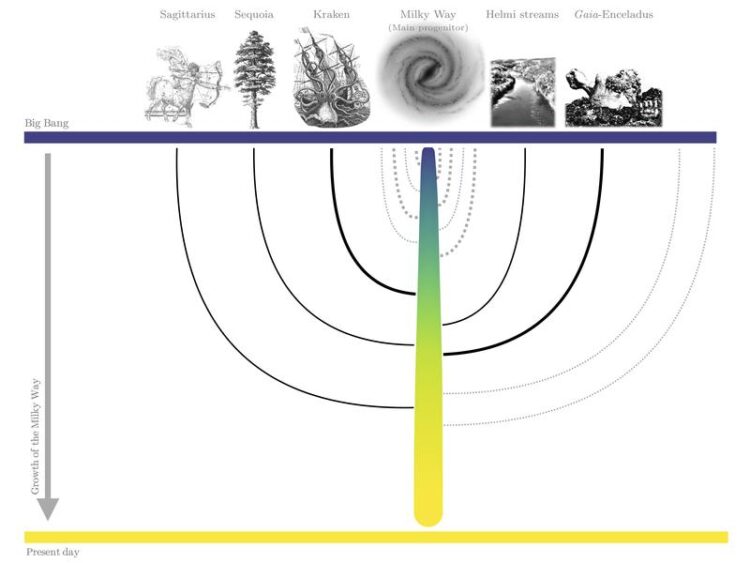Milky Way Family Tree

Family tree of the Milky Way. The main progenitor of the Milky Way is denoted by the trunk of the tree, coloured by stellar mass. Black lines indicate the five identified galaxies.
D. Kruijssen
Astrophysicists reconstruct the galaxy merger history of our home galaxy.
Galaxies like the Milky Way formed by the merging of smaller progenitor galaxies. An international team of astrophysicists led by Dr Diederik Kruijssen from the Centre for Astronomy at Heidelberg University has succeeded in reconstructing the merger history of our home galaxy, creating a complete family tree. To achieve this, the researchers analysed the properties of globular clusters orbiting the Milky Way with artificial intelligence. Their investigations revealed a previously unknown galaxy collision that must have permanently altered the appearance of the Milky Way.
Globular clusters are dense groups of up to a million stars that are almost as old as the universe itself. The Milky Way hosts over 150 of such clusters. “Many of them came from smaller galaxies that later merged to form the Milky Way that we live in today,” explains Dr Kruijssen. To study the merger history, the Heidelberg researcher and his colleague Dr Joel Pfeffer of Liverpool John Moores University (United Kingdom) and their research groups developed a suite of advanced computer simulations, called E-MOSAICS. These simulations include a complete model for the formation, evolution, and destruction of globular clusters.
The German-British team used these simulations to relate the ages, chemical compositions, and orbital motions of the globular clusters to the properties of the progenitor galaxies in which they formed, more than ten billion years ago. By applying these insights to groups of globular clusters in the Milky Way, they not only determined how massive these progenitor galaxies were, but also when they merged with our home galaxy.
“The main challenge was that the merger process is extremely messy, because the orbits of the globular clusters are completely reshuffled,” explains Dr Kruijssen. “To overcome this complexity, we developed an artificial neural network and trained it on the E-MOSAICS simulations. We were astonished at how precisely the artificial intelligence allowed us to reconstruct the merger histories of the simulated galaxies, using only their globular clusters.” The researchers then applied the neural network to groups of globular clusters in the Milky Way and precisely determined the stellar masses and merger times of the progenitor galaxies. They also discovered a previously unknown collision between the Milky Way and an unknown galaxy, which the researchers named “Kraken”.
“The collision with Kraken must have been the most significant merger the Milky Way ever experienced,” Dr Kruijssen adds. Before, it was thought that a collision with the Gaia-Enceladus galaxy some nine billion years ago was the biggest collision event. However, the merger with Kraken took place eleven billion years ago, when the Milky Way was four times less massive than today. “As a result, the collision with Kraken must have truly transformed what the Milky Way looked like at the time,” explains the Heidelberg scientist.
Taken together, these findings allowed the team of researchers to reconstruct the first complete family tree of our home galaxy. Over the course of its history, the Milky Way cannibalised about five galaxies with more than 100 million stars, and about ten more with at least ten million stars. The most massive progenitor galaxies collided with the Milky Way between six and eleven billion years ago. Dr Kruijssen expects that these predictions will aid the future search for the remains of the progenitor galaxies. “The debris of more than five progenitor galaxies has now been identified. With current and upcoming telescopes, it should be possible to find them all,” the Heidelberg researcher concludes.
The research results were published in “Monthly Notices of the Royal Astronomical Society”.
Contact:
Communications and Marketing
Press Office
Phone +49 6221 54-2311
presse@rektorat.uni-heidelberg.de
Wissenschaftliche Ansprechpartner:
Dr Diederik Kruijssen
Center for Astronomy of Heidelberg University (ZAH)
Phone +49 6221 54-1877
kruijssen@uni-heidelberg.de
Dr Guido Thimm
Center for Astronomy of Heidelberg University (ZAH)
Phone +49 6221 54-1805
thimm@ari.uni-heidelberg.de
Originalpublikation:
J.M.D. Kruijssen, J.L. Pfeffer, M. Chevance, A. Bonaca, S. Trujillo-Gomez, N. Bastian, M. Reina-Campos, R.A. Crain, M.E. Hughes: Kraken reveals itself – the merger history of the Milky Way reconstructed with the E-MOSAICS simulations, 2020, MNRAS 498, 2472-2491, doi: 10.1093/mnras/staa2452; https://arxiv.org/abs/2003.01119
Weitere Informationen:
http://wwwstaff.ari.uni-heidelberg.de/kruijssen/News/News.html
Media Contact
All latest news from the category: Physics and Astronomy
This area deals with the fundamental laws and building blocks of nature and how they interact, the properties and the behavior of matter, and research into space and time and their structures.
innovations-report provides in-depth reports and articles on subjects such as astrophysics, laser technologies, nuclear, quantum, particle and solid-state physics, nanotechnologies, planetary research and findings (Mars, Venus) and developments related to the Hubble Telescope.
Newest articles

You are What You Eat—Stanford Study Links Fiber to Anti-Cancer Gene Modulation
The Fiber Gap: A Growing Concern in American Diets Fiber is well known to be an important part of a healthy diet, yet less than 10% of Americans eat the minimum recommended…

Trust Your Gut—RNA-Protein Discovery for Better Immunity
HIRI researchers uncover control mechanisms of polysaccharide utilization in Bacteroides thetaiotaomicron. Researchers at the Helmholtz Institute for RNA-based Infection Research (HIRI) and the Julius-Maximilians-Universität (JMU) in Würzburg have identified a…

ASXL1 Mutation: The Hidden Trigger Behind Blood Cancers and Inflammation
Scientists show how a mutated gene harms red and white blood cells. LA JOLLA, CA—Scientists at La Jolla Institute for Immunology (LJI) have discovered how a mutated gene kicks off…



